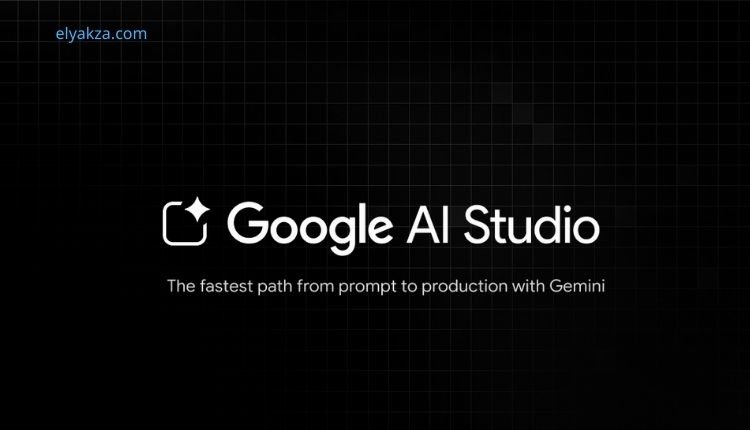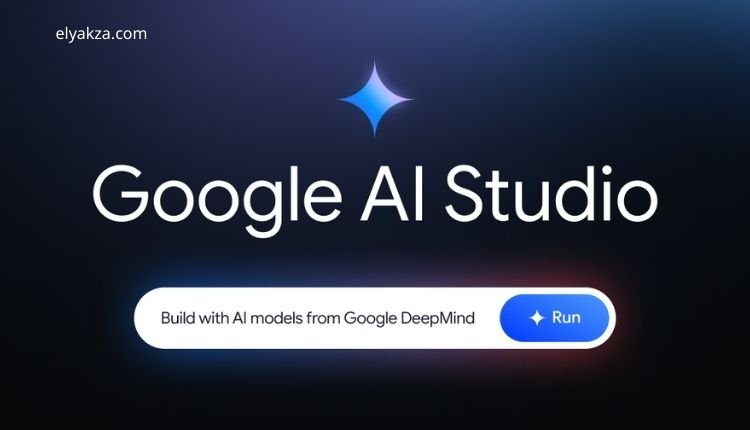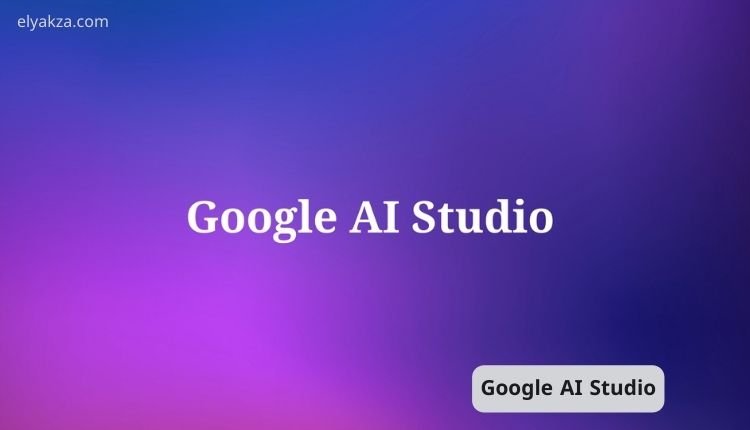Artificial intelligence has become the backbone of modern software development. From image generation to creating entire web applications, AI is no longer limited to developers with years of coding experience. With platforms like Google AI Studio, anyone with an internet connection and a Google account can launch functional AI-driven projects—without paying a single cent and without writing complex lines of code.
قائمة المحتويات
In this in-depth guide, I will share everything you need to know about Google AI Studio: how it works, what makes it unique, how it compares to other Google AI services, and how you can use it to create your own applications. I will also walk you through real-world examples like building a photo editor, generating QR codes, and even creating complete landing pages—all powered by Google AI models.
By the end of this article, you’ll not only understand the capabilities of Google AI Studio but also feel confident enough to launch your first project today.
What Is Google AI Studio?
Google AI Studio is a cloud-based platform developed by Google that allows users to create and manage AI-powered projects using simple commands. Unlike traditional programming environments, you don’t need to spend weeks learning programming languages or frameworks. Instead, you provide instructions (known as prompts), and the platform automatically generates functional applications, code, or tools.
Essentially, Google AI Studio is a no-code/low-code environment that connects directly with Google’s APIs and models. It gives you instant access to advanced AI systems such as Nano Banana, Gemini 2.5 Pro, and other state-of-the-art large language models.
Whether you want to create a photo editor, generate QR codes, or design a complete website, Google AI Studio enables you to do it with minimal effort and no upfront cost.
Why Choose Google AI Studio?
There are plenty of AI platforms available today, but Google AI Studio stands out for several reasons:
- Free Access – You can start building AI-powered projects without paying anything.
- Integration with Google Ecosystem – It connects directly with Google Cloud, Gemini, and other Google APIs.
- User-Friendly Interface – The platform is designed for beginners and professionals alike.
- No-Code Functionality – Even non-programmers can create functional applications.
- Scalability – Once your project is ready, you can easily deploy it using Google Cloud for production-level performance.
This makes Google AI Studio an ideal tool not only for beginners but also for developers who want to prototype quickly.
“Read Also: Google Workspace Pricing“
Getting Started with Google AI Studio
The onboarding process is straightforward. Here’s how you can get started:
- Sign Up with a Google Account
Simply visit the Google AI Studio website and log in with your Gmail. No extra registration is required. - Access the Dashboard
Once logged in, you’ll be directed to the main dashboard where you can browse existing projects or create new ones. - Start a New Project
With just one command, you can launch a project. For example, typing “Create a photo editor using Nano Banana” will generate a ready-to-use tool. - Experiment with Models
Google AI Studio allows you to select from multiple AI models (Nano Banana, Gemini Pro, Gemini Flash, etc.) depending on your project requirements. - Preview and Edit
Every project comes with a live preview and editable code. You can refine your project, add new sections, or make adjustments without starting over.
Real-World Use Cases of Google AI Studio
Let’s explore practical applications you can build with this platform.
1. AI-Powered Photo Editor
One of the most exciting demonstrations of Google AI Studio is the creation of a photo editor. By giving a single command such as “Build me a photo editing tool using Nano Banana”, the platform generates a fully functional application.
With this editor, you can:
- Upload images directly.
- Apply filters, cropping, and retouching.
- Adjust lighting and contrast.
- Generate entirely new visuals from text prompts.
This is especially valuable for content creators, graphic designers, and social media managers who need quick edits without investing in expensive software.
2. QR Code Generator
Another popular example is creating a QR code generator. By instructing Google AI Studio, you can build a tool that:
- Accepts any URL.
- Generates a QR code instantly.
- Allows mobile users to scan and access the content immediately.
For businesses, this means you can create promotional QR codes for events, discounts, or product launches without relying on third-party tools.
3. Landing Page Builder
Google AI Studio can also help you generate complete landing pages. By providing a structured prompt such as “Create a landing page to promote a new online course”, the system:
- Structures the page with headlines, body text, and call-to-action buttons.
- Suggests animations and responsive layouts.
- Optimizes the design for mobile, tablet, and desktop views.
This capability is a game-changer for marketers who want to test campaigns quickly without hiring developers.
“Read Also: Google Workspace vs. Zoho Workplace“
How Google AI Studio Compares to Gemini
Many users wonder how Google AI Studio differs from Gemini, another AI service offered by Google.

- Google AI Studio is primarily a project-building platform. It focuses on no-code/low-code project generation.
- Gemini is a set of AI models (like Gemini 2.5 Pro and Flash) that provide raw AI capabilities such as text generation, image creation, or advanced problem-solving.
In short, Google AI Studio uses Gemini (and other models) as its engine. While Gemini provides the “intelligence,” Google AI Studio provides the interface, tools, and project management features to make that intelligence accessible.
“Read Also: Professional Business Emails with Google Workspace“
Step-by-Step Example: Building a Landing Page
To better illustrate how this works, let’s walk through the process of creating a landing page for a new product.
- Enter a Command
Example: “Create a promotional landing page for an AI-based photo editor.” - System Analysis
The platform interprets your request and generates a draft. - Code Generation
It creates the full HTML, CSS (e.g., Tailwind), and JavaScript/React components. - Preview Mode
You can see the landing page in real time, with responsive layouts for mobile and tablet. - Refinement
Add sections like FAQs, video demos, or customer testimonials with a single instruction. - Export or Deploy
Once satisfied, you can download the project files or deploy them directly to Google Cloud.
Within minutes, you have a professional landing page ready to use—no coding required.
“Read Also: Google Notebook for Education“
Advantages of Using Google AI Studio
Let’s break down the biggest benefits of this platform:

- Time Efficiency: Projects that would take weeks of coding are built in minutes.
- Cost Savings: No software licenses or upfront fees required.
- Accessibility: Anyone with a Google account can participate.
- Flexibility: Works with multiple programming frameworks (React, Angular, TypeScript).
- Scalability: Projects can start simple but grow into enterprise-level solutions.
Limitations of Google AI Studio
Of course, no tool is perfect. While Google AI Studio is powerful, there are some limitations:
- Learning Curve for Customization
Non-technical users may struggle when editing advanced code. - Dependence on Google Cloud
To deploy at scale, you may need to subscribe to Google Cloud services. - Processing Time
Some complex tasks (like large image generation) may take longer to execute. - Limited Offline Use
Since it’s cloud-based, you must stay connected to the internet.
Best Practices for Success
If you want to maximize your results with Google AI Studio, keep these tips in mind:
- Start Simple: Begin with small projects (like QR code generators) before attempting large applications.
- Leverage Instructions: Provide clear and detailed prompts to guide the AI effectively.
- Iterate Often: Use the preview feature to refine your project step by step.
- Explore Examples: Study pre-built projects within the platform for inspiration.
- Plan for Deployment: If you’re serious about scaling, integrate your project with Google Cloud early.
Future of Google AI Studio
The rise of platforms like Google AI Studio suggests a clear direction: AI is becoming increasingly accessible. In the near future, we can expect:
- Deeper integration with third-party APIs.
- More AI models available within the platform.
- Advanced templates for e-commerce, education, and entertainment.
- Stronger collaboration tools for teams.
As AI continues to evolve, Google AI Studio will likely play a central role in democratizing software development.
Google AI Studio: the Conclusion
Google AI Studio is more than just an AI tool—it’s a revolution in how we build software. With the ability to create photo editors, QR code generators, landing pages, and even more complex applications, the platform proves that the future of development lies in no-code AI environments.
Whether you’re a beginner exploring AI for the first time or a professional developer looking to save time, Google AI Studio offers an intuitive, powerful, and cost-effective solution.
If you’re serious about leveraging AI in your personal or professional projects, there has never been a better time to explore this platform. Start small, experiment often, and let Google AI Studio show you what’s possible when creativity meets artificial intelligence.
David Elon is a writer focused on Google services and tools, offering practical guides and tutorials on how to maximize the potential of platforms like Google Ads, Google Analytics, Google Drive, and Google Workspace.
Through his content, David helps readers—from beginners to professionals—understand how to use Google’s ecosystem efficiently for both personal productivity and business growth. He covers tips, best practices, and case studies that make the most out of Google’s features.
David’s approach combines technical know-how with easy-to-follow instructions, making his work a trusted resource for entrepreneurs, marketers, and students alike. His passion lies in enabling users to harness the full power of Google’s tools to achieve their goals.

